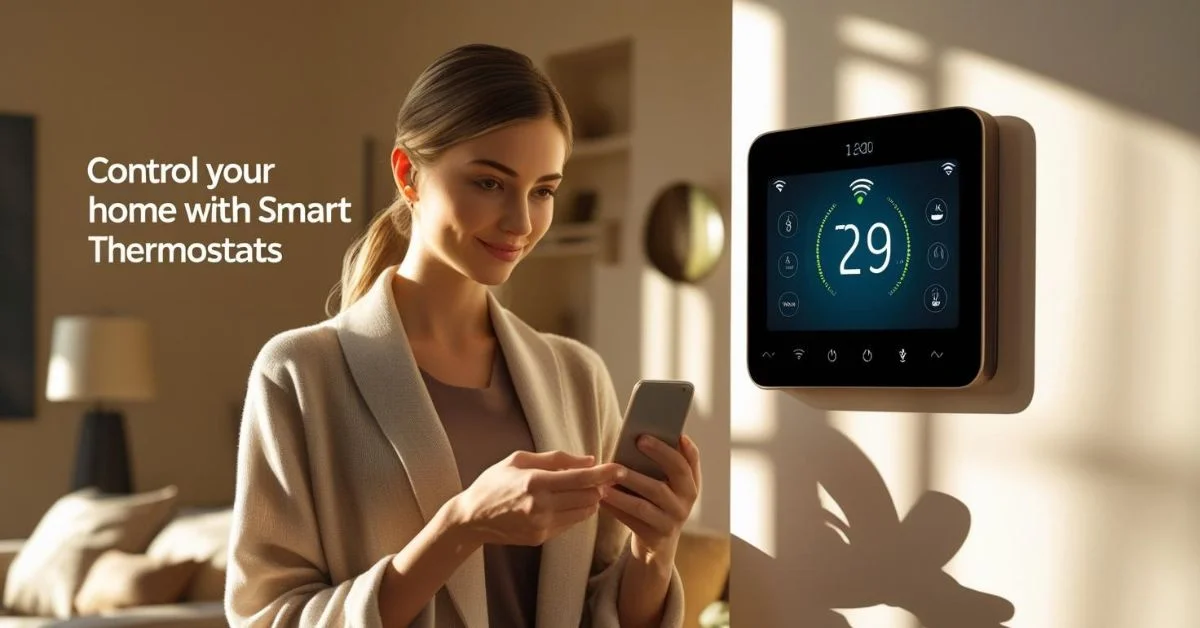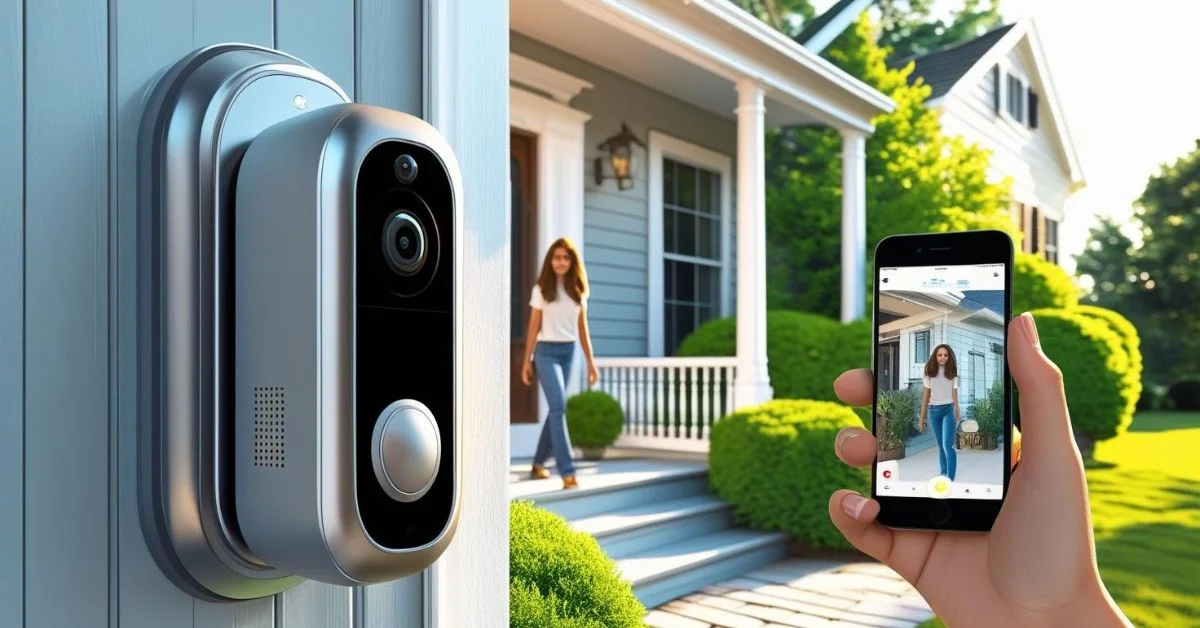Imagine never having to get up to adjust your home’s temperature again. Smart thermostats have transformed how we control the temperature and comfort of our homes. With just a few taps on your phone or a simple voice command, you can control your home’s heating and cooling from anywhere. These modern devices not only make life more convenient, but they also help cut down on energy costs, up to 20% annually, according to the U.S. Department of Energy. They offer the perfect balance of convenience and cost savings.
What Are Smart Thermostats?
A smart thermostat is a Wi-Fi-enabled device that lets you manage your heating and cooling system from anywhere. Unlike traditional thermostats that require manual adjustments, smart thermostats can learn your daily routine and adjust the temperature automatically.
Key features include:
- Remote control through smartphone apps.
- They work seamlessly with voice assistants like Alexa, Google Assistant, and Siri for hands-free control.
- Learning capabilities to build a schedule around your habits.
- Energy usage reports and savings tips.
- Geofencing to adjust settings when you leave or return home.
These features not only make your HVAC system smarter but also simplify your life. For example, during summer months, your smart thermostat can automatically cool the house before you arrive home from work, ensuring comfort the moment you step inside. Or during winter, it can lower the heat while you sleep, then warm up your space before your morning alarm.
How Smart Thermostats Work?
Smart thermostats use sensors and internet connectivity to monitor and adjust your home’s temperature. They gather data on your behavior and preferences, then use this information to create an efficient schedule.
Here’s a breakdown:
- Wi-Fi Connectivity: Allows remote access and control.
- Sensors: Detect occupancy, temperature, and humidity.
- Learning Algorithms: Adjust based on your daily routine.
- Geofencing: Uses your phone’s location to manage settings.
- Mobile App Control: Lets you change settings from anywhere.
Many models can even factor in local weather conditions to fine-tune your home’s temperature. Others use motion detectors to sense when rooms are occupied and regulate temperature based on activity levels.
Benefits of Smart Thermostats
Discover how smart thermostats enhance your home’s efficiency, comfort and control.
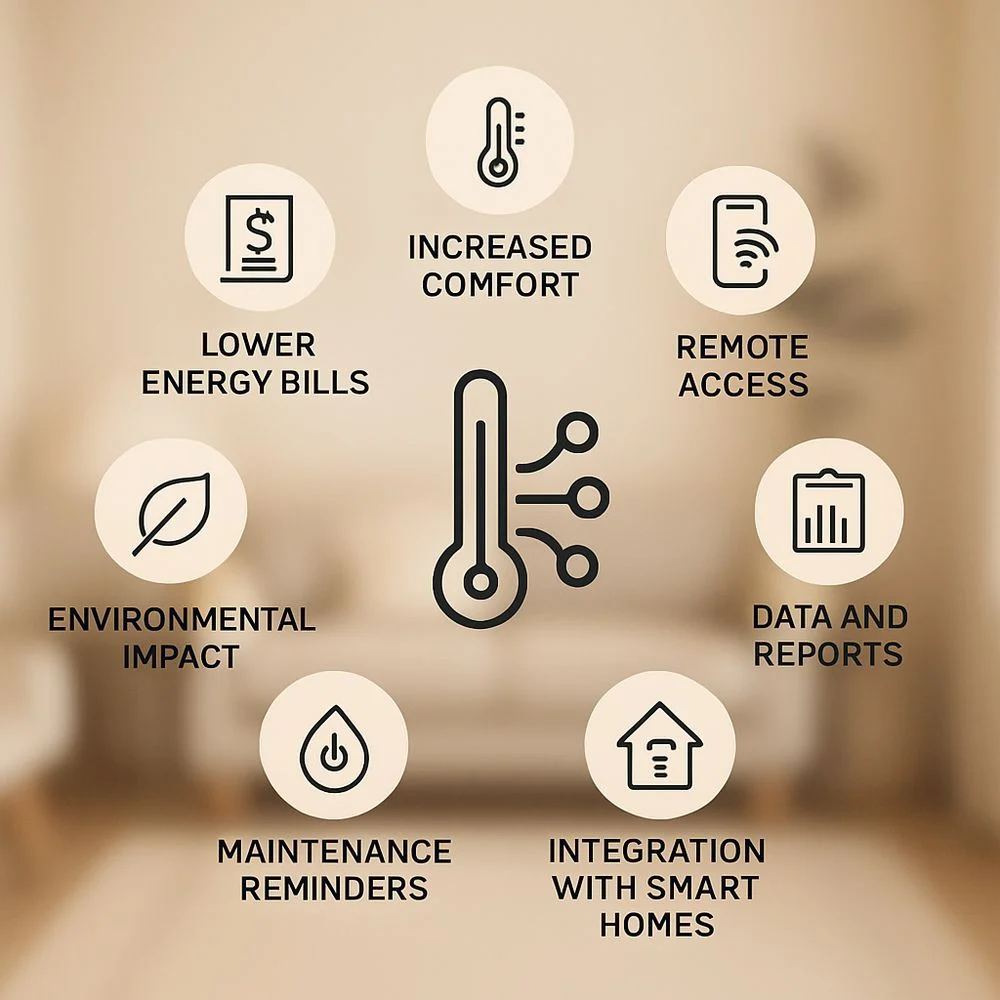
1. Lower Energy Bills
Smart thermostats help reduce energy consumption by only running your HVAC system when needed. This can lead to savings of 8% to 20% on heating and cooling costs annually, depending on your home and climate.
Additionally, some utility companies offer incentives or rebates for using a smart thermostat. These programs not only reduce the upfront cost but also increase your total savings.
2. Increased Comfort
By learning your preferences, smart thermostats maintain your ideal temperature throughout the day. Add-on room sensors allow you to maintain even temperatures in various rooms, improving overall comfort. Whether you prefer a cooler bedroom and a warmer living area, these devices can create that environment.
3. Environmental Impact
Less energy use means a smaller carbon footprint. Choosing a smart thermostat is a simple way to make your home more sustainable. By cutting down on unnecessary heating or cooling, you’re reducing fossil fuel use and helping the planet.
4. Remote Access
Whether you’re at work, on vacation or just in bed, you can control your thermostat from your phone. This remote-control capability lets you manage energy use efficiently, even when you’re away. For example, if you forget to turn off the AC before leaving for a trip, you can do it from the airport.
5. Integration with Smart Homes
Smart thermostats often work with other smart devices. You can create routines like “Good Morning” or “Bedtime” to automate multiple functions at once. Imagine waking up to a warm room, the lights slowly turning on and the coffee machine starting, all from a single voice command.
6. Maintenance Reminders
Many smart thermostats alert you when it’s time to change your air filters or schedule HVAC maintenance, helping your system last longer and run more efficiently. Smart thermostats also send maintenance alerts, helping you avoid costly repairs and maintain cleaner air indoors.
7. Data and Reports
Many models provide energy reports that reveal how and when you use heating or cooling, helping you optimize settings for better efficiency. You can see when and where you’re using the most energy and make adjustments. These insights empower you to make informed decisions that save money month after month.
Choosing the Right Smart Thermostat
When picking a smart thermostat, consider the following factors:
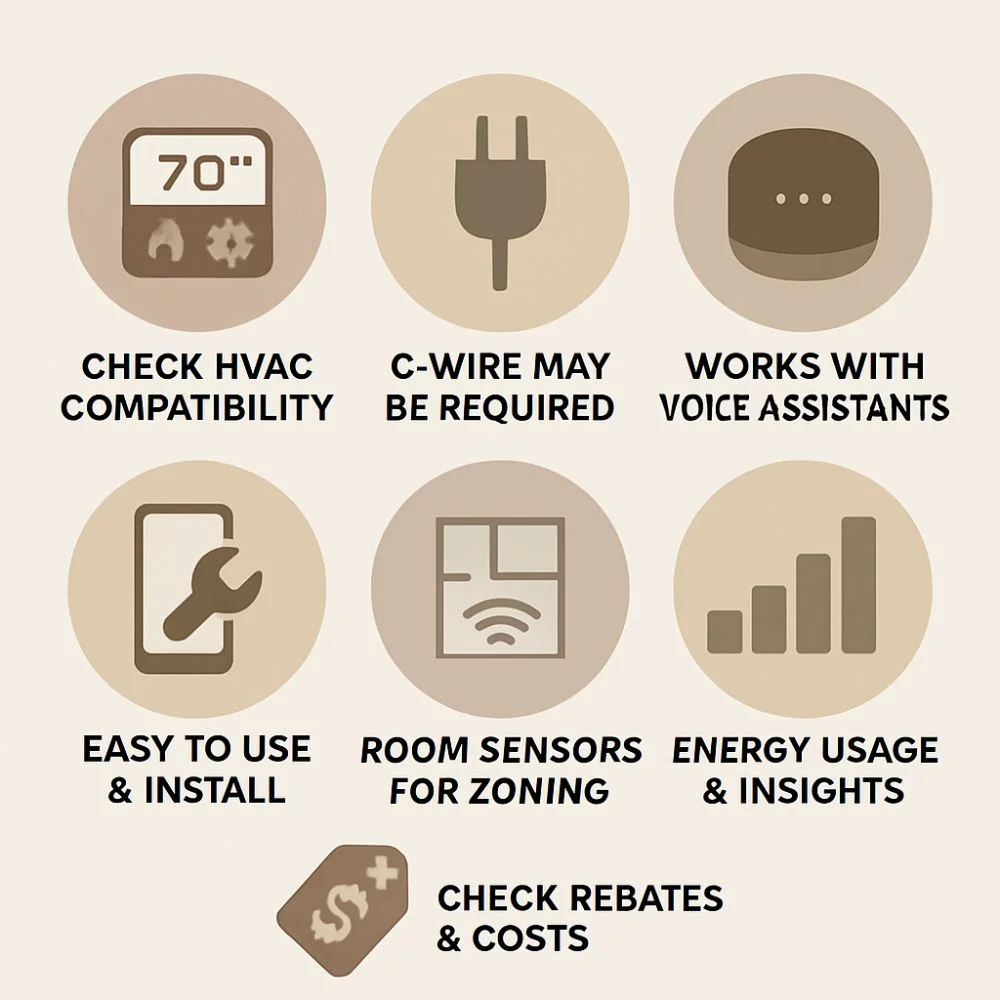
- HVAC Compatibility: Not all thermostats work with every heating or cooling system. Check the specifications before buying.
- Wiring Needs: Some models require a C-wire for power. Make sure your system supports it.
- Smart Assistant Integration: Choose a thermostat that works with the voice assistant you use most.
- Ease of Use: Look for a user-friendly app and clear installation instructions.
- Sensors and Zoning: Extra room sensors can improve comfort in larger homes.
- Data Insights: Useful graphs and tips help you understand your energy usage.
- Budget and Rebates: Smart thermostats range from $100 to $300. Look for utility rebates that can reduce the cost.
Also, consider design and interface. A sleek and intuitive display makes a difference in daily use. If you’re managing a large home or rental property, choose a model with advanced scheduling and multi-zone control.
Popular Smart Thermostat Models
Here are some top-rated options:
- Google Nest Learning Thermostat: Learns your schedule, supports most systems and has a sleek design. It offers HVAC monitoring, energy history tracking and remote control via the Google Home app.
- Ecobee SmartThermostat Premium: Offers voice control with Alexa built-in, air quality monitoring and room sensors for improved zoning. It also works with Apple HomeKit and SmartThings.
- Amazon Smart Thermostat: Affordable and works well with Alexa. It’s an ideal choice for those new to smart home technology.
- Honeywell Home T9: Easy setup, excellent app interface and zoning support. Its Smart Room Sensors detect motion and temperature to deliver comfort where it matters.
Each of these models brings unique strengths. Make sure to match features with your specific needs.
Installation and Setup
Installing a smart thermostat is often simple, especially if your current system supports it. Here’s a general guide:
- Turn off power to your HVAC system.
- Remove the old thermostat and label the wires.
- Mount the new thermostat and connect wires as instructed.
- Turn the power back on and follow the setup prompts.
- Simply link the thermostat to your Wi-Fi and download the app to get started.
- Customize your settings manually or allow the thermostat to learn your habits and adjust automatically over time.
Some brands offer step-by-step video tutorials. If your system doesn’t have a C-wire or has complex wiring, hiring a certified installer ensures safety and accuracy.
Tips to Maximize Energy Savings
Follow these practical tips to get the most energy savings from your smart thermostat:
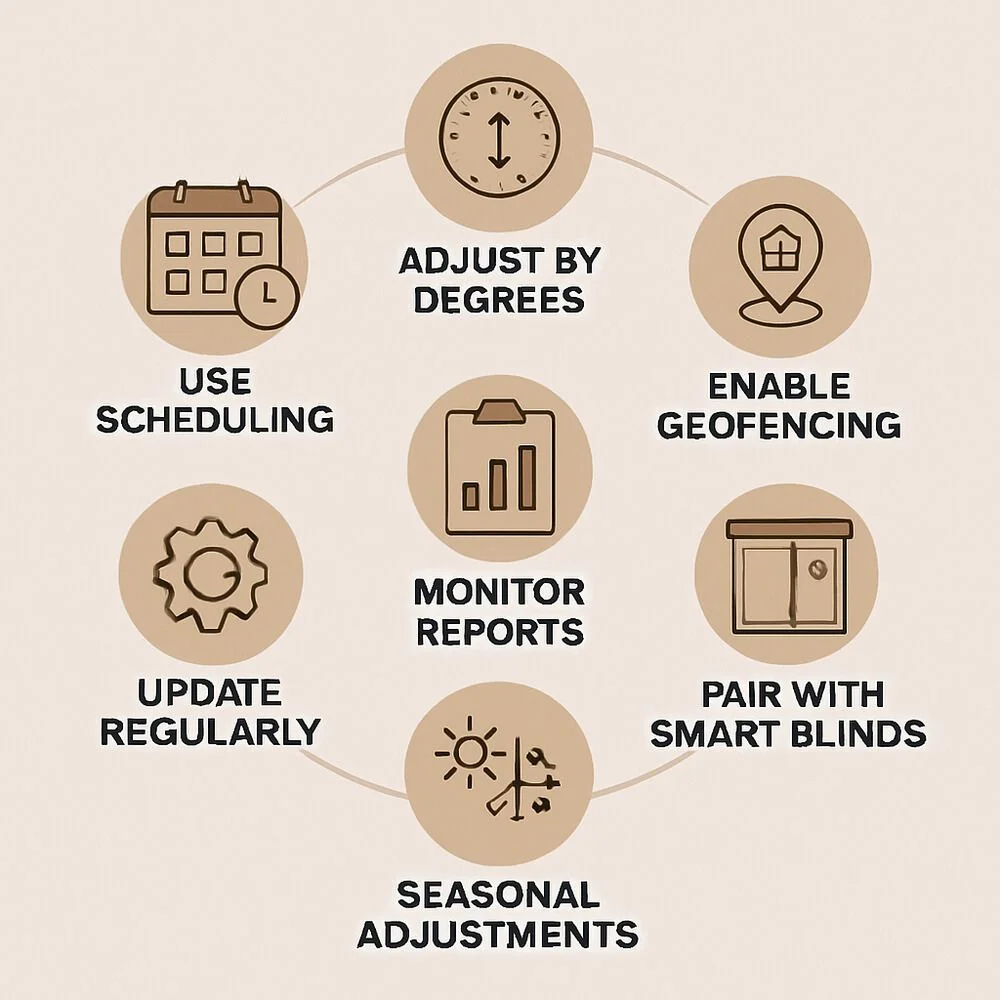
- Adjust by Degrees: Lowering your heat or raising your cooling by just a few degrees saves energy.
- Use Scheduling: Let your thermostat follow your daily routine.
- Enable Geofencing: Automatically adjust settings when you’re away.
- Monitor Reports: Use data to identify opportunities for savings.
- Update Regularly: Ensure your device has the latest features and security patches.
- Pair with Smart Blinds or Curtains: Let your thermostat work with other devices to control sunlight and maintain indoor temperatures more effectively.
- Seasonal Adjustments: Make minor tweaks to your schedule with each season for optimal performance.
Are Smart Thermostats Worth It?
Absolutely. Though they cost $100–$300, smart thermostats typically pay for themselves within 1–2 years through energy savings, averaging $180 annually, according to Energy Star. In addition to cutting costs, smart thermostats enhance comfort, support eco-friendly living, and can increase your home’s market appeal. Whether you’re a homeowner or renter, smart climate control is a smart investment.
Frequently Asked Questions (FAQs)
1. Do smart thermostats save money?
Yes, they can reduce energy bills by 8–20% annually by adjusting temperatures efficiently.
2. Can I install one myself?
Most are easy to install if your system is compatible. Complex setups may need a pro.
3. Will it work without Wi-Fi?
Yes, but without Wi-Fi, you won’t be able to use features like remote control, scheduling or smart automation.
4. Are all smart thermostats compatible with my HVAC?
Not all. Check compatibility with your system before buying.
5. Can renters use smart thermostats?
Yes, with landlord approval. Some models don’t require wiring.
6. Which voice assistants do they support?
Most support Alexa, Google Assistant and Apple HomeKit.
7. How much do they cost?
They range from $100–$300. Rebates from energy providers can lower the price.
Final Thoughts
Upgrading to a smart thermostat is one of the easiest ways to make your home more energy-efficient and comfortable. These devices combine technology and convenience, helping you save money and reduce your carbon footprint.
With smart thermostats, you gain full control over your home’s climate, whether you’re in the living room, at work, or miles away. If you’re ready to upgrade, now is the perfect time to make the switch. Choose wisely, set it up correctly and start enjoying a smarter and more comfortable home.
Whether you are tech-savvy or just looking for convenience and savings, a smart thermostat is a smart choice.
